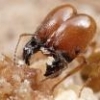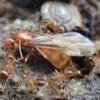![IMG 20160928 194934005[1] IMG 20160928 194934005[1]](https://www.formiculture.com/uploads/gallery/album_652/gallery_1170_652_5277714.jpg)
![IMG 20160928 194927830[1] IMG 20160928 194927830[1]](https://www.formiculture.com/uploads/gallery/album_652/gallery_1170_652_4354812.jpg)
![IMG 20160928 194923803[1] IMG 20160928 194923803[1]](https://www.formiculture.com/uploads/gallery/album_652/gallery_1170_652_2775767.jpg)
![IMG 20160928 194845080[1] IMG 20160928 194845080[1]](https://www.formiculture.com/uploads/gallery/album_652/gallery_1170_652_4019689.jpg)
![IMG 20160928 173246218[1] IMG 20160928 173246218[1]](https://www.formiculture.com/uploads/gallery/album_652/gallery_1170_652_4337483.jpg)
I caught these worker ants in a rural area outside of Statesboro, Georgia.
They were under a few blocks of wood on the porch of a house no one has lived in for years.
I haven't measured them, but these workers are longer than my keyboard keys are wide. They're huge compared the the Trachymyrmex septentrionalis I caught yesterday.
They have dark red heads, orange/yellow thoraxes, and dark (almost black) abdomens. Their bodies are covered in long hairs. The halves of their antennae that are closer to their heads are very thick compared to the outer ends. Their heads are shaped like corn kernels, and they have fairly large jaws.
They moved very quickly once I disturbed their nest. The wood had obviously been chewed into; I'm guessing these are carpenter ants of some sort.
I didn't take a picture of the wood I found them under.
The freezer in one of the pictures was where I found a Solenopsis invicta queen; there was a large nest of fire ants living in and directly under the lid of the freezer. The main storage bin of the freezer was loaded with gigantic maggots.




















